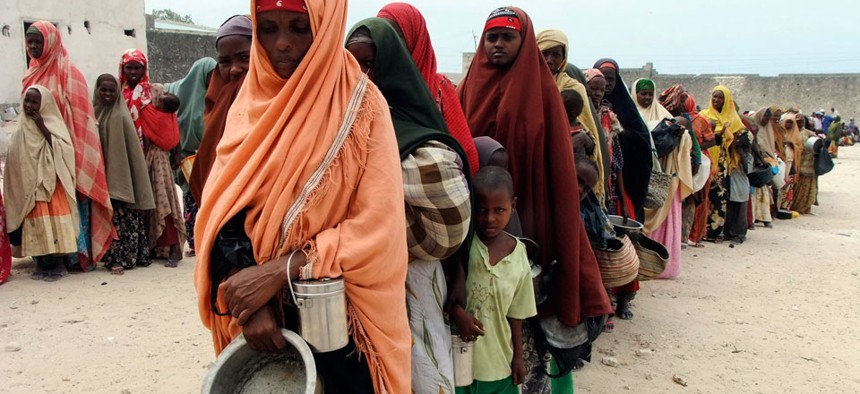
Somali women and children from southern Mogadishu, line up to receive food at a camp in Mogadishu. Farah Abdi Warsameh/AP
How USAID and Science Agencies Tap Data to Forecast Famine
Early warning network helps program leaders direct aid where it’s needed.
The Partnership for Public Service and IBM Center for the Business of Government recently issued “From Data to Decisions III: Lessons from Early Analytics Programs,” which examines successful early government users of data to see how they got started, what sustained them and how the data was used to improve mission-critical programs.
The report identifies lessons learned to help federal leaders and managers avoid pitfalls, instill analytics faster and move more efficiently and effectively to create data-driven cultures.
The following case study, the final in a series of three excerpted from the report, examines how federal agencies analyze data to forecast famines.
Using Social and Environmental Data to Pinpoint the Next Food Crisis
The world awoke slowly to the famine in Ethiopia and Sudan, which lasted from 1983to1985. Only after shocking images of masses of starving and dying people were televised did humanitarian aid flow. Even then, Ethiopia’s embattled Marxist government was slow to distribute it, and between 400,000 and 1 million people died.
As a result of this experience, the U.S. Agency for International Development created the Famine Early Warning Systems Network, or FEWS NET, in 1985 to speed response to future famines and prevent a repeat of Ethiopia’s massive loss of life.
FEWS NET was built to help USAID deliver its $1 billion in annual food aid where it was most needed and would do the most good, says Gary Eilerts, the network’s program manager.
Humanitarian aid is enmeshed in politics. In Africa, where the network focused first, governments can be reluctant to announce a food emergency, which can be read as an admission of policy failure. Aid-giving governments face withering criticism if they drum up assistance for a crisis that fails to materialize or if it is seen to be bolstering enemies. And famines are slow-onset disasters in places where drought, poverty, illness, malnourishment and lack of sanitation are endemic.
When a crisis call is unpopular, difficult and fraught with political implications, it has to be correct. That’s where the famine warning network comes in.
From the beginning, the network relied on a mix of social and physical science data to determine, more precisely than ever before, which parts of the population in which regions of which countries would suffer most from environmental shocks -- usually drought.
Chris Funk and James Verdin of the U.S. Geological Survey wrote in their analysis: “Effective early warning combines a successful blend of Earth observations, hydrologic modeling, food economics, weather and climate modeling, and much more.”
While the network does warehouse data in computerized environments, it doesn’t rely fully on automated analytical algorithms, preferring instead to merge human and software analysis. Eilerts says he isn’t sure software can capture and make sense of the subtleties and nuances that experienced observers can apply.
All the science and much of the social data, for example, may show that the food crisis is approaching famine level in Nigeria, Elierts says. “But I know the area, and a lot of people are sending remittances home from outside Nigeria, so it’s not,” he says. “Each situation is very local; it’s about human behavior.”
The USGS is the network’s most active science partner, but it’s hardly alone. It includes the Agriculture Department, the National Aeronautics and Space Administration, and the National Oceanic and Atmospheric Administration. The science agencies provide satellite remote-sensing data, modeling, forecasting, geographic information systems, training and analysis.
NASA research scientist Molly Brown says an analysis of the impact of drought as measured both by vegetation anomalies and rainfall deficits needs to be integrated with information on elevated food prices, migration patterns and water scarcity.
A contractor compiles the analysis into tightly written food security outlooks, alerts and briefs for decision-makers in USAID’s Food for Peace and disaster assistance offices, the State Department, Congress, the White House, the United Nations World Food Program, humanitarian assistance organizations and other governments.
To download the From Data to Decisions III: Lessons from Early Analytics Programs report, visit www.ourpublicservice.org.
-30-







